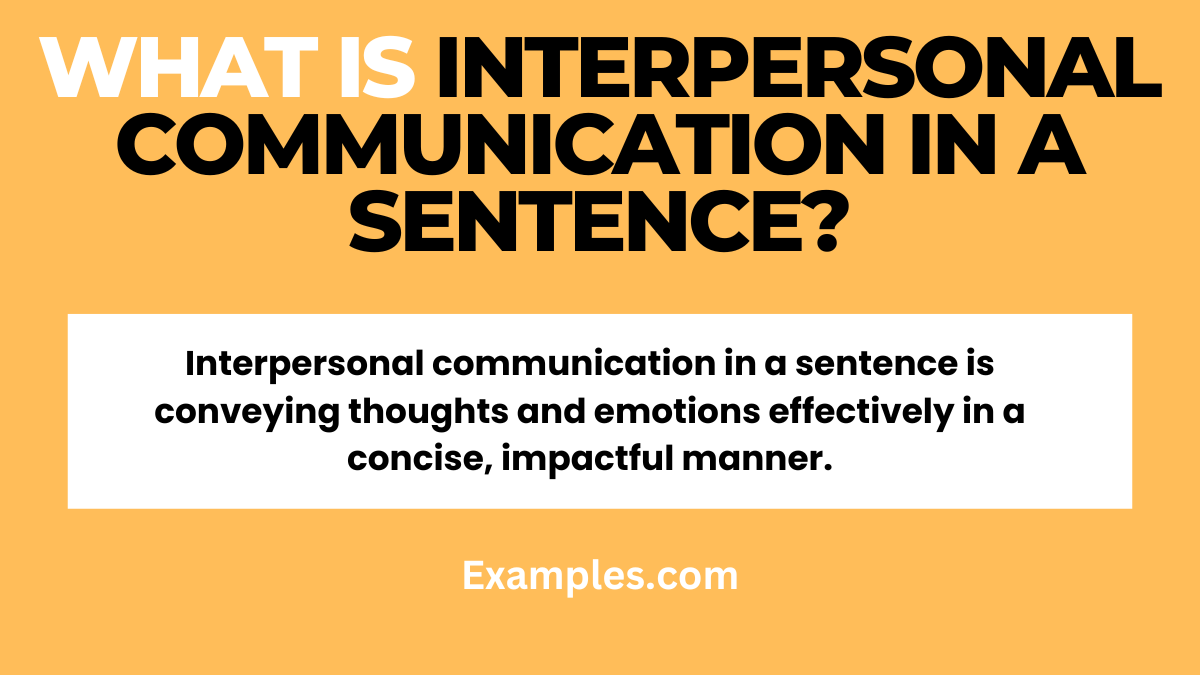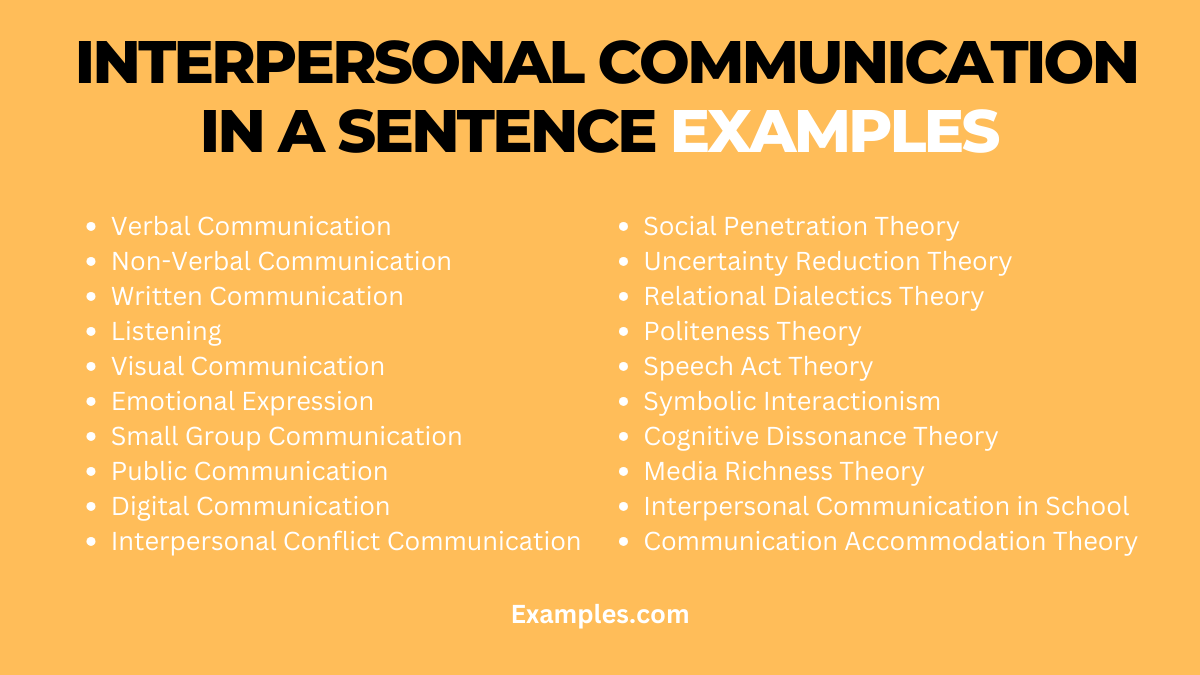19+ Interpersonal Communication Sentence Examples
Interpersonal communication in a sentence focuses on conveying clear, concise, and impactful messages within a single sentence. This skill, particularly important in oral communication, involves choosing the right words and tone to deliver a message effectively. It’s about making every word count, ensuring that the intended meaning is accurately understood. This form of communication is crucial in various settings, from professional to personal, where brevity and clarity are essential. Mastering this skill can lead to more effective and efficient communication.
What is Interpersonal Communication in a Sentence?

Interpersonal communication in a sentence is the ability to express ideas, thoughts, and emotions effectively and concisely in just one sentence. It’s a vital skill in interpersonal communication, emphasizing the power of brevity and clarity. This concept is particularly important in today’s fast-paced world, where being able to communicate succinctly can make a significant difference in how messages are received and understood. It’s about delivering maximum impact with minimum words.
20 Interpersonal Communication in a Sentence Examples

Interpersonal communication is pivotal in shaping relationships and interactions in various settings. Understanding types of interpersonal communication and their effective use can greatly enhance personal and professional relationships. This article explores 20 unique and distinct examples of interpersonal communication, providing insight into how different forms of communication can be applied in everyday situations.
1. Verbal Communication:
- “Could you please help me understand this report?”
- Explaining or asking for clarification in a polite tone is a key aspect of verbal communication, fostering understanding and collaboration.
2. Non-Verbal Communication:
- “She nodded in agreement.”
- Non-verbal cues like nodding signify agreement or understanding without using words, an essential part of effective interpersonal communication.
3. Written Communication:
- “The email outlined the project details clearly.”
- Well-structured written communication, like emails, conveys information clearly and effectively.
4. Listening:
- “I’m listening, go on.”
- Active listening involves giving full attention and showing engagement in the conversation, enhancing mutual understanding.
5. Visual Communication:
- “The presentation used graphs to illustrate the trends.”
- Using visual aids like graphs in presentations helps convey complex data more effectively.
6. Emotional Expression:
- “I feel happy about our project’s progress.”
- Expressing emotions openly can build trust and understanding in professional relationships.
7. Small Group Communication:
- “Let’s discuss this in our team meeting.”
- Facilitating discussions within a small group encourages diverse perspectives and collaborative decision-making.
8. Public Communication:
- “The speech at the conference was inspiring.”
- Effective public speaking, like giving speeches, can motivate and influence a larger audience.
9. Digital Communication:
- “We communicated the updates through a group chat.”
- Utilizing digital platforms for quick and efficient information exchange is a modern aspect of interpersonal communication.
10. Interpersonal Conflict Communication:
- “We resolved the misunderstanding through a calm discussion.”
- Addressing conflicts with calm and clear communication prevents escalation and fosters resolution.
11. Social Penetration Theory:
- “Over time, our conversations have become more personal and deep.”
- This theory explains how relationships progress from superficial to more intimate levels of communication.
12. Uncertainty Reduction Theory:
- “I asked questions to get to know my colleague better.”
- Reducing uncertainty in new interactions is crucial for building comfortable and effective relationships.
13. Relational Dialectics Theory:
- “We balance our need for independence with our desire for closeness.”
- This theory highlights the ongoing negotiation of opposing needs in a relationship.
14. Communication Accommodation Theory:
- “I adjusted my speech to be more formal in the meeting.”
- Adapting communication styles to fit the context or audience is a strategic interpersonal skill.
15. Politeness Theory:
- “I made sure to thank them for their help.”
- Using polite language and expressions fosters respect and positive interactions.
16. Speech Act Theory:
- “My promise to help was a commitment.”
- Understanding how different types of speech acts, like promises, affect interactions is important.
17. Symbolic Interactionism:
- “We use symbols like thumbs-up to show approval.”
- Symbolic gestures play a significant role in conveying messages in interpersonal communication.
18. Cognitive Dissonance Theory:
- “I felt uneasy when my actions didn’t align with my beliefs.”
- Recognizing and addressing cognitive dissonance is crucial for personal integrity and effective communication.
19. Media Richness Theory:
- “We chose a video call for a more personal conversation.”
- Selecting the appropriate media for communication is key to conveying the message effectively.
20. Interpersonal Communication in Everyday Life:
- “I chat with my neighbor every morning.”
- Regular, informal conversations are fundamental to building and maintaining social connections.
Interpersonal Communication Sentence for Students
- Understanding Context: Students often use interpersonal communication to collaborate on projects, sharing ideas and feedback.
- Building Relationships: It helps in forming friendships and understanding peers’ perspectives.
- Conflict Resolution: Useful in resolving disagreements amicably through discussion and understanding.
- Enhancing Learning: Encourages active participation in class discussions, enhancing learning experiences.

- Developing Empathy: Fosters empathy by understanding diverse viewpoints.
- Improving Language Skills: Regular practice enhances vocabulary and articulation.
- Career Preparation: Essential for future professional interactions, interviews, and networking.
Interpersonal Communication Sentence for Manager
- Leadership Communication: Managers use interpersonal communication to lead teams effectively, conveying vision and goals.
- Feedback Mechanism: Essential for providing constructive feedback to employees.
- Conflict Management: Helps in addressing and resolving workplace conflicts.
- Motivating Employees: Effective communication motivates and boosts employee morale.

- Decision Making: Facilitates collaborative decision-making processes.
- Building Trust: Establishes trust and rapport with team members.
- Change Management: Communicates organizational changes and their impact effectively.
Importance of Interpersonal Communication Sentence?
- Enhances Relationships: Vital in building and maintaining personal and professional relationships.
- Effective Teamwork: Crucial for teamwork and collaboration.
- Conflict Resolution: Aids in resolving conflicts through understanding and empathy.
- Personal Development: Improves self-awareness and social skills.
- Career Advancement: Enhances job prospects and professional growth.
- Cultural Understanding: Promotes understanding of different cultural perspectives.
- Emotional Intelligence: Improves emotional intelligence, aiding in social interactions.
How do you use intrapersonal communication in a sentence?
- Self-Reflection: “In my daily journaling, I engage in intrapersonal communication to reflect on my experiences and emotions.”
- Decision Making: “When deciding on a career path, I used intrapersonal communication to evaluate my strengths and aspirations.”
- Goal Setting: “I often use intrapersonal communication to set personal goals and assess my progress.”
- Problem-Solving: “Whenever I face a dilemma, I turn to intrapersonal communication to weigh my options and find solutions.”
- Emotional Regulation: “Through intrapersonal communication, I practice mindfulness to manage stress and regulate my emotions.”
- Self-Motivation: “I motivate myself through positive self-talk, a form of intrapersonal communication.”
- Personal Growth: “Engaging in intrapersonal communication is crucial for my personal development and self-improvement.”
In mastering interpersonal communication, it’s crucial to recognize its multifaceted nature. Whether it’s through effective listening or understanding the nuances of non-verbal cues, every interaction we engage in is an opportunity to build stronger, more meaningful connections. Remember, interpersonal communication is not just about conveying a message; it’s about creating a shared understanding and fostering relationships. By continually refining our skills in this area, we open doors to deeper connections in both personal and professional realms. Always stay aware of the diverse types of interpersonal communication and actively work towards enhancing your proficiency for a more connected world.



